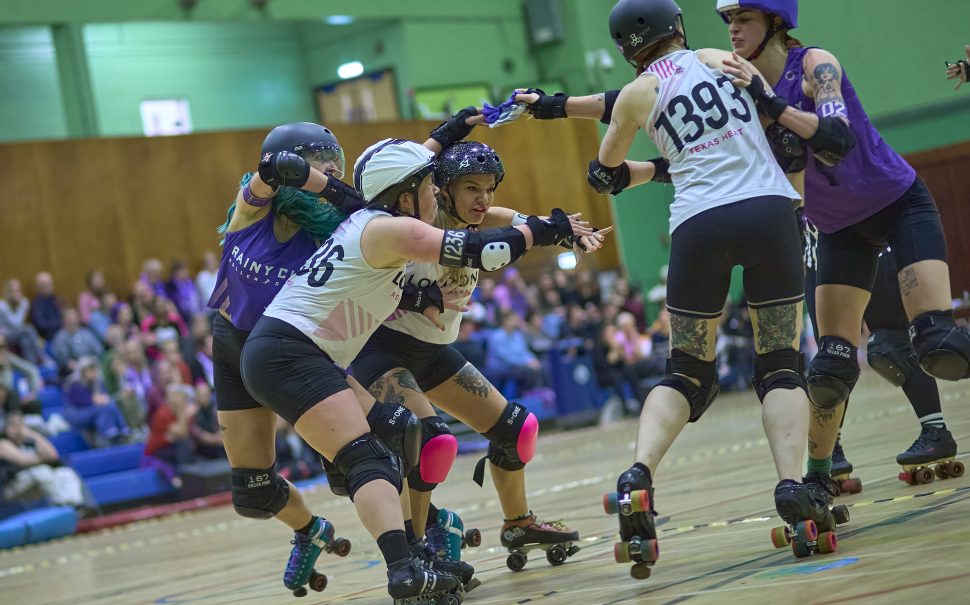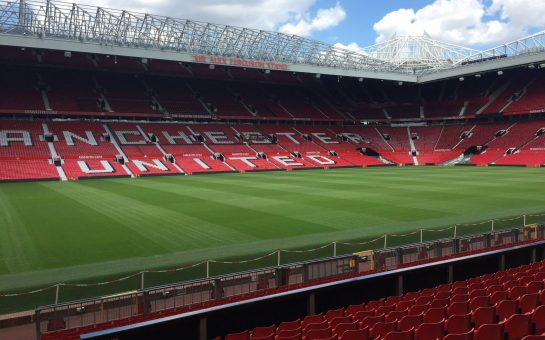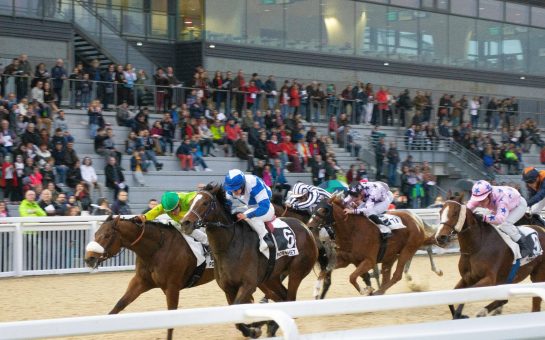Manchester, like Roller Derby, has always been a home for outsiders – but many Mancunians may not know that our very own Rainy City Roller Derby league has one of the best teams in the world. We went to find out more about the sport for the alternative athlete, and the community that they have built.
I walk into a leisure centre in Bury, and the old-school sports hall echoes with the clash of skates, the wails of players, and the rhythmic thud of bodies hitting the track.
The crowd – full of neon hair, tattoos, and big, friendly smiles – can’t be more than a hundred people, but what they lack in numbers they make up for in noise and enthusiasm.
And on the track, we see pandemonium – or perhaps it’s better to say controlled chaos.
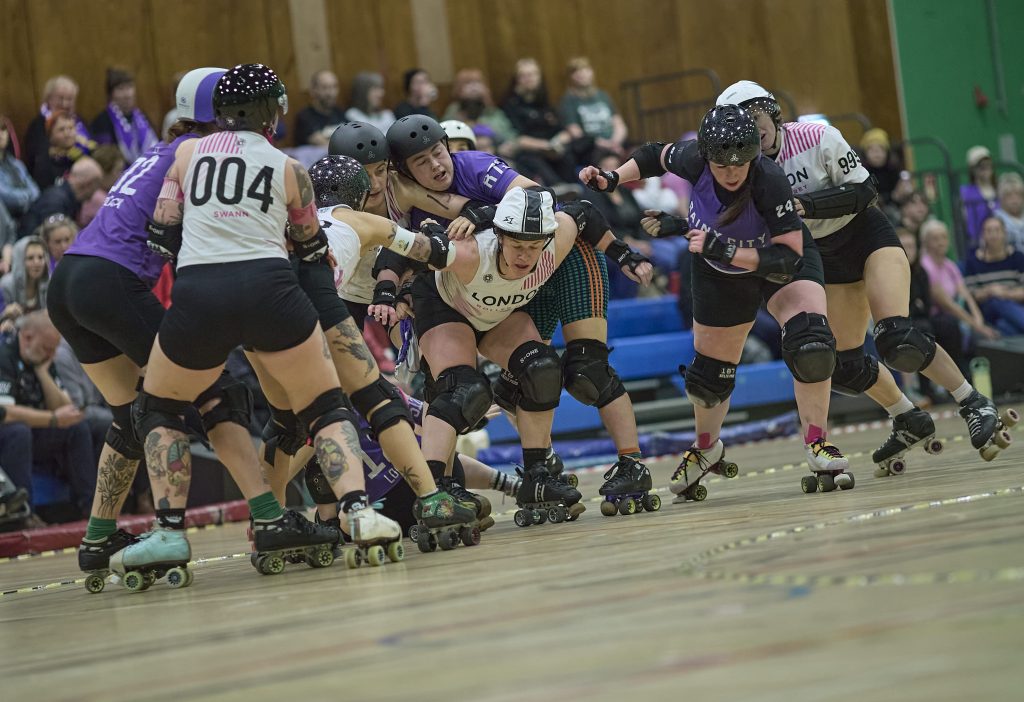
Elbows and bodies collide and jostle whilst the brave players cunningly weave and slam through the mass of bodies blocking them. Meanwhile, the colour commentary on the side of the track entertains with cheesy jokes, and drag-inspired pop-queen Chappell Roan plays in the background.
Welcome to Rainy City Roller Derby. The Manchester based league has four teams, two of which compete as part of the UK Roller Derby Association and the Women’s Flat Track Derby Association.
I’m here to check out what the sport is all about. Manchester’s Rainy City has one of the best teams in the world, so it’s a good place to find out.
I won’t try and explain all the rules, but for the basics:
- The game is played on a flat track. The bout takes place over two 30-minute halves.
- There are two teams, with five players from each team on the track at any one time.
- Of those five, one is designated as the jammer, who can score points. They score by passing the players on the other team as they go around the flat track.
- The other four players will try to block the jammer and stop them from scoring points.
There are lots of other rules as well – pivots, penalties, official reviews, the sin-bin and more – but a full understanding of every rule isn’t required to enjoy the game. And despite the astonishing sights it can bring with its athleticism and, at times, brutality, I don’t think the spectacle is where the appeal ends.
I think the real heart of Roller Derby lies in the people who play it – what motivates them, the community they have built, and their love for the sport and each other. Those who play aren’t usually your typical people who compete in sports.
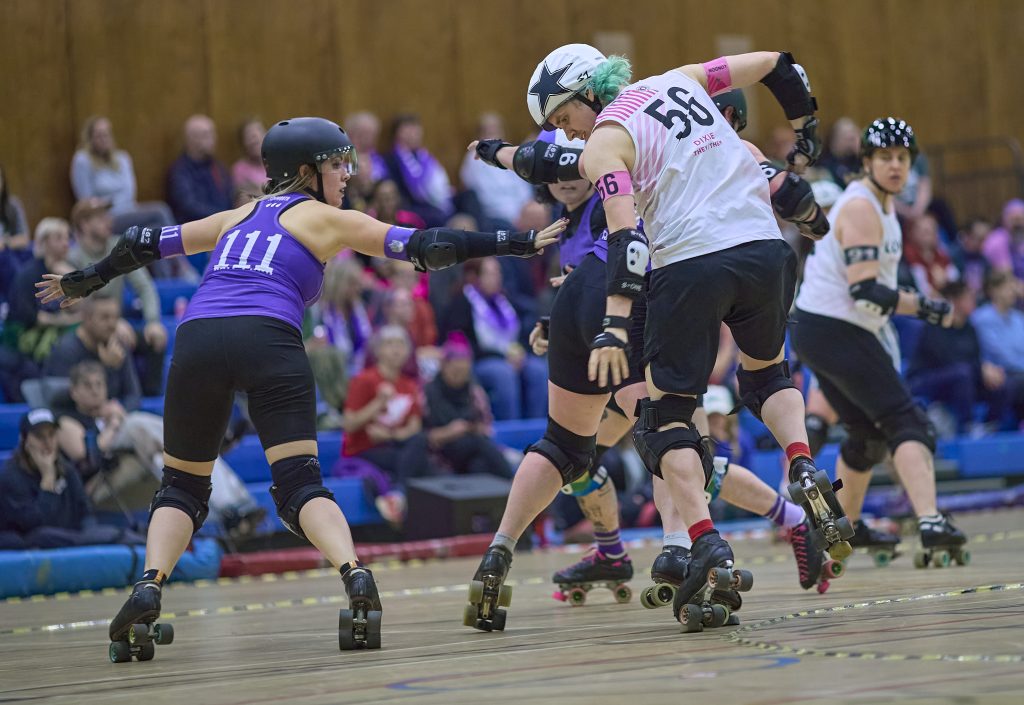
Jenni Palmer plays as a blocker for Reckoning, Rainy City’s B-team. She said that before Roller Derby came into her life, she had “never really been involved or engaged with sport”. As an outsider, that world felt blocked off to her.
“I didn’t think that I was someone who could play sports – I am plus sized and I’m disabled”, Jenni said.
“But I found roller derby and it was a community for me, it was very welcoming and it was a space where other people were the same as me, they hadn’t been involved in sports previously as well. So I just think it’s a really good sport if you have always been on the outside of being an ‘athlete’.”
This inclusivity is woven into the fabric of Rainy City – it is unashamedly vibrant, alternative and queer. And this is really where you can begin to see the bricks and mortar of the community it has built up compared to more traditional athletic spaces.
It’s not just about the game – it’s about belonging.
A new recruit to Rainy City, Lauren, spoke about this to us through her own experiences.
Lauren said: “I think what’s really good is how it’s obviously open to people who are non-binary and trans – I’m trans and I’m really worried about being accepted into sports, so this is somewhere where I can really do it and enjoy it without that sort of stupid worry that comes with that.
“30 years ago it (trans people in sport) seemed to be no problem at all and now it seems to be suddenly a problem and I don’t really get why. I really worry about the bad media around that and being able to play with other women as part of a team is, for me, really important.”
That community also extends out to how Roller Derby is run. There is a DIY, almost punk-rock ethos to the sport that mirrors or perhaps even shapes its spirit.
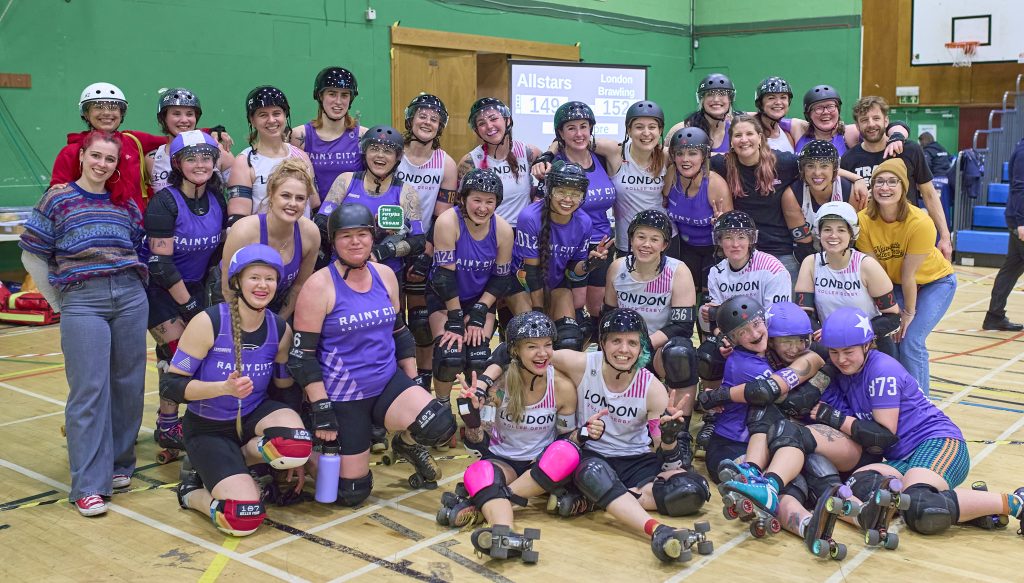
Teams are built on the dedication of volunteers who run social media accounts, design merchandise, sort out the venues, run the press office, do safety and concussion protocol, amongst many, many other things.
Dr Claire Stapleton is a jammer for Reckoning, and uses the name Sonic Boom on the track. She has been playing for around ten years.
She told us: “It is about giving back – there are people who put a lot of time in coaching, and you know we obviously can’t hold games and matches without a whole crew of refs and non-skating-officials, so it is about giving back what you can – there is a whole league that wouldn’t run without volunteers.”
“I see it with my kids’ sport – those opportunities wouldn’t be there if there weren’t volunteers in the community that are running things behind the scenes. I think it’s important that you are able to contribute where you can, give a little back and volunteer.”
However, whilst the DIY ethos and the alternative culture are at the heart of Roller Derby, we must also as well talk about the sport itself – it is entertaining, rough, deeply strategic and visually awe-inspiring.
“You can’t just be good at skates to play at a top level, you’ve got to be quick thinking on the track and know the strategy,” Claire tells us.
“Sometimes what marks a difference between the top players is being able to communicate to the people you are playing with, so all the blockers are working together – bringing all those things together is what makes it not only physically challenging but mentally challenging as well.”
“I’ve never played a sport that has that same intensity and same challenge – I have played a high level of hockey and tennis, and it doesn’t have that same thrill.”
The sports’ unique blend of athleticism and aggression means injuries are inevitable. Players take big hits to the ground and each other – calculating split-second moves to outwit opponents can, obviously, go wrong. Bruises, and even broken bones, come with the territory.
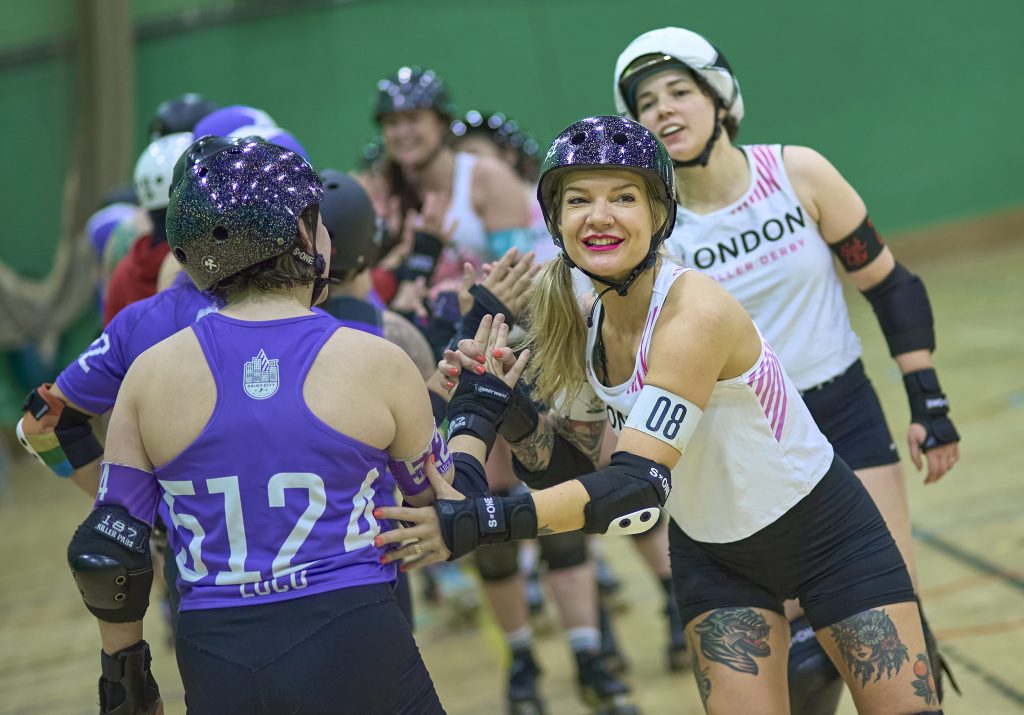
But so does the reward and thrill of playing and, in Claire’s words, “the elation of finishing a game”. She comes from a background in physiotherapy, and as a lecturer has guided student projects around injuries in roller derby.
“I think it looks worse than what it is sometimes – it looks quite brutal to watch, but actually when someone is on skates sometimes it’s hitting the floor that hurts more than actually getting hit by somebody else,” Claire said.
“I’ve been fortunate and not had big injuries, and you do see some big injuries, I think it’s just part of the sport.”
Whilst roller derby thrives on the intensity and the bone-rattling hits, leagues like Rainy City prioritise their players’ health. There is a foundation of safety and support, with robust safety measures and assurances that newcomers aren’t thrown straight into the deep-end.
Jenni Palmer told us: “I think what I would say is that you don’t join roller derby and play roller derby straight away. You learn to skate and you learn to skate safely, you have to be rookie ready and there is a slow process to make it safer. One of the things I would say about Rainy is that we have a really strong concussion protocol.”
In the games I attended, the main event was Rainy City’s A-team, the All-Stars, competing against their London rivals, Brawling. These teams take each other on often, and it’s always a close encounter. This match was no different.
Rainy City came so close to winning – they were within seconds and a couple of points of taking the game – but in the end, London took a hard-fought victory. It was thrilling. In this sense, roller derby was like any other competitive sport.
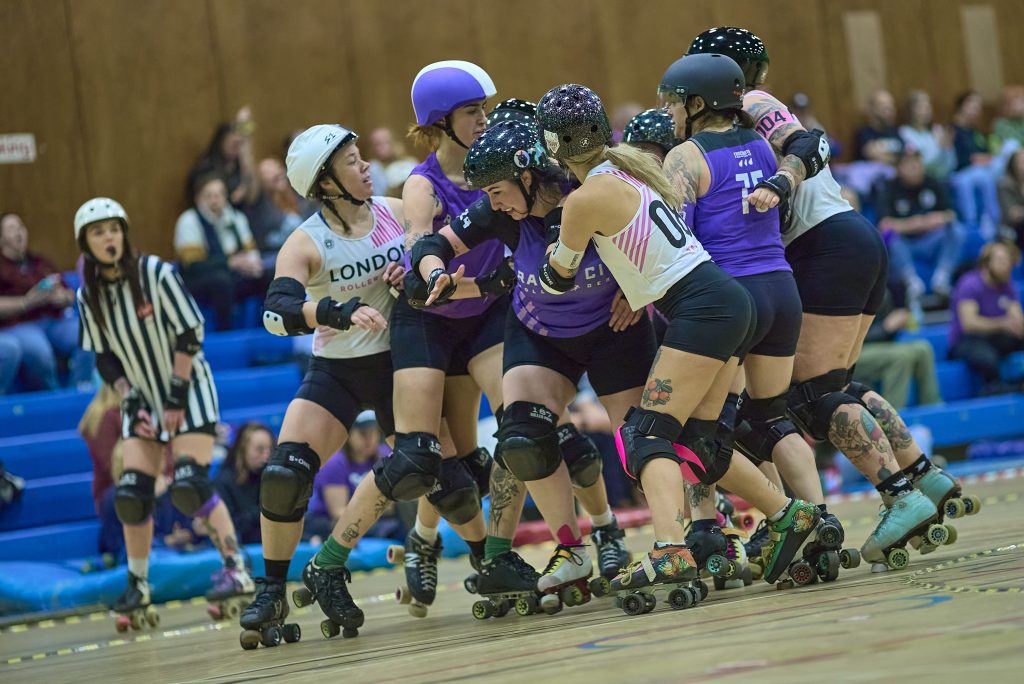
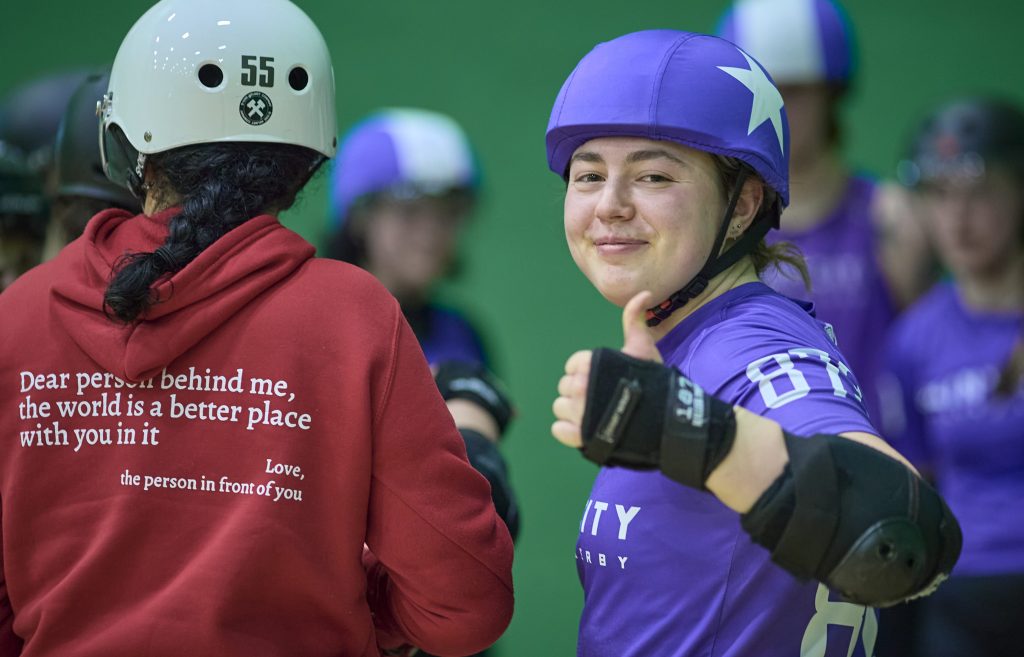
But it is also more than that. In a world where the mainstream has rigid norms about who can and can’t be in sports, derby opens its arms to the world in all its varieties, colours, creeds and backgrounds.
Claire puts it well: “I just think that it has got different types of people involved that makes it a lot more inclusive and non-judgemental. It doesn’t matter who you are, what your sexuality or gender is, it’s actually open to all – body size, shape as well is key to that.”
Check out Rainy City Roller Derby’s website or social media accounts to get a ticket for upcoming games, or maybe even get on the track yourself.
All images taken by and used with permission from Roller Derby on Film.
